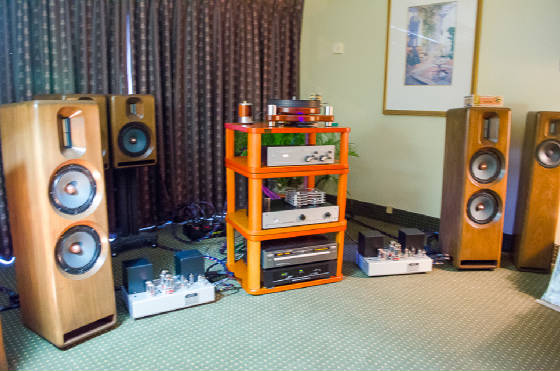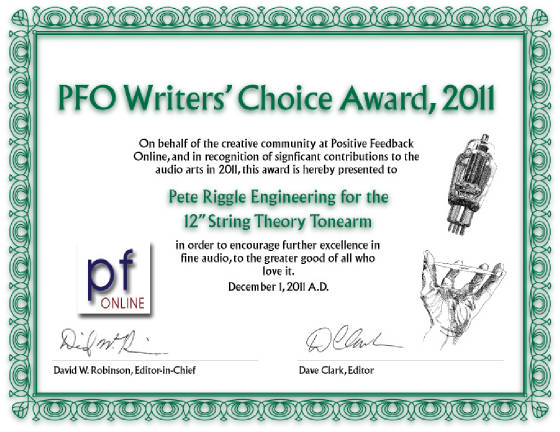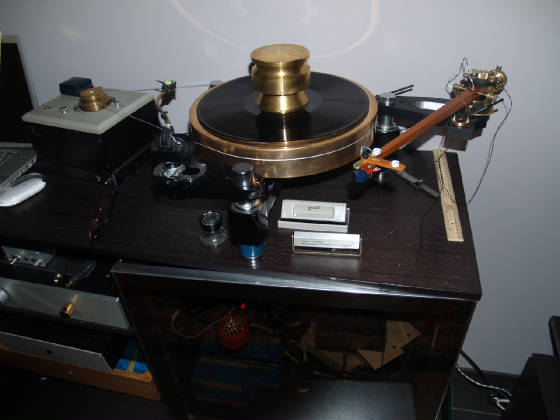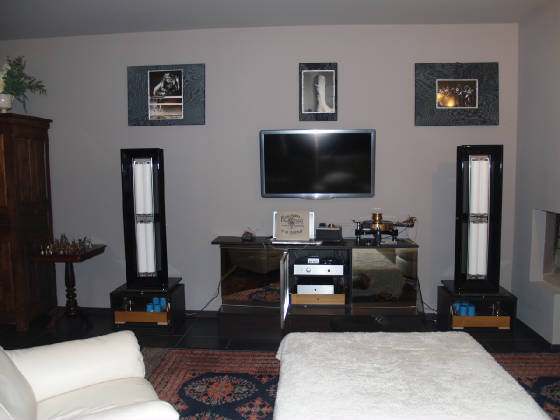|
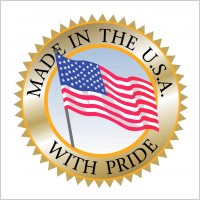 The reviews on this web page are for the Woody Universal tonearm. For reviews of the Woody SPU tonearm (for Ortofon SPU cartridges with integral headshell), click on the following link:
"Compare the Woody tone arms at $1,900 to the Schroeder and Reed tone arms in the $4,000 to $5,000 range, and the Durand arms priced at $16,500."
-Pete Riggle "I
can not suggest that there is a single tonearm on the market that competes with this product at or anywhere
near its price point, and I think that speaks volumes of its worth. What Pete offers as a package
is a tough competitor. It makes a hell of a versatile option for someone who cannot say that price is no object." - VinylRob, Audio Karma
forum, Southeast Michigan Audio Club "The Woody.
. . has to be the most adjustable tonearm one can buy. . . a fascinating product... timberally colorful, well textured sound, with notably excellent image
depth. . . a lovingly made tonearm . . ." -Art Dudley, Stereophile "I could never afford to purchase a Schroeder, and The Woody is every bit as good. Every parameter you could want is easily adjustable;
and it's so damn beautiful,and so musical too." -
Ted Danowski "With each record, the well-produced ones and the marginal ones, the music contained details and nuances that [prior listening] had failed to reveal." "I sat stunned...it was the most live- and lifelike I have every heard in a vinyl recording, packed with detail and nuances in this huge sound stage. Simply, the sound was magnificent." "The Woody tone arm is extremely well designed in clearly an Occam's Razor approach, based on a solid principle of parsimony, economy, or succinctness applied with Pete Riggle's considerable engineering and tone arm problem-solving skill." "Within a few notes of the first record, I noticed how large the sound stage became. I focused next on how much more detail was present in the music. Virtually every record stunned me." "The bottom line is that the Woody is a keeper, and likely to be the last tone arm I will ever own. It is that good."
-Mike Bodell, Bend Oregon
Woody Tonearm Reviews:
http://www.positive-feedback.com/Issue56/stringtheoryarm.htm "Beneath that beautiful French polished wood lies a remarkable bit of creative thinking in regards to the obstacles presented by analog playback and neatly executed engineering solutions. If you value a hand crafted product and the passion and integrity of a designer, than I would suggest you give the String Theory arm serious consideration." "The defining characteristic of the String Theory arm is its combination of proper tonal color and its unflappable expression of micro dynamics that make up music. What this translates to is this: music has a robust and fleshed out tonal balance, yet the fine detail which makes it realistic is not lost in the pleasing texture of the music." Thad Aerts review, Part 1, in Hifizine http://www.hifizine.com/2011/06/pete-riggle-engineering-stringtheory-woody-tonearm/ "For being a rather sophisticated design, the Woody was a snap to set-up and the whole process (alignment included) took me a little over an hour. Again, I already had the VTAF installed (which makes a big difference in terms of time) and I made periodic minor tweaks as I listened to music. Still, Riggle is to be applauded for the thought that he put into the arm’s design – not to mention its stunning aesthetics ." Thad Aerts review, Part 2, in Hifizine http://www.hifizine.com/2011/09/riggle-stringtheory-tonearm-part-2/ Thad compares the Woody to his modified Rega RB250, which uses Incongnito wire, the Pete Riggle VTAF, and the Pete Riggle Counterweight for the Common Man, all of which are dramatic improvements to the RB250: "The best analogy I can muster to describe the differences I heard between the two tonearms was that the Rega (greatly improved by modifications) was like watching a really high quality tubed television. Then, take the same program material you just viewed and watch it on a state of the art plasma or LCD or whatever. There is really no contest. The Woody brought more air to whatever it played while also raising the level of definition. There were many times while listening where I wondered how much better it could really get short of better equipment downstream. It is, hands down, the best tonearm I’ve ever had the pleasure of hearing. Throw in its stellar good looks and ridiculous ease of set-up and you have a clear winner."
"There was a lot to
see and hear in the Orion room . . . Sitting atop the rack was a George Warren turntable (prices start at $3,700, without
tonearm). This clever, well thought out, and genuinely pretty turntable actively monitors and corrects platter speed. Did
you see that the motor sits on only two feet? It leans into the belt to provide the right amount of line tension. Like I said,
very clever. Mounted here was a Pete Riggle "Woody" tonearm ($1,920); the
VTA, azimuth, and anti-skating can all be adjusted on the fly. A Soundsmith
Hyperion cartridge walked the grooves. Sound in this room was explosive
. . ."
"Designer
Pete Riggle walks me through his $1600 Woody tonearm. On his website http://www.vtaf.com/id82.html he compares it to Joel
Durand's $16,500 Telos. When I entered the room Joel was there inspecting Riggle's Woody.
That just sounds wrong doesn't it?" See
Michael Fremer's interview of Pete Riggle going over the Woody tonearm features at the following link: http://www.analogplanet.com/content/designer-pete-riggle-shows-me-his-woody-tonearm
The Tonearm Bargain of the Year, Submitted by Jim Tavegia: "I hope he keeps the price there as this might be the tonearm to get many of us really jumping into the realm of improving our turntables. These are the kinds of innovators who need support." Woody Tonearm, Submitted by luvvinyl: "This is my personal tonearm! If you want a giant slayer, this is it! Pete
Riggle is an amazing guy and so is his tonearm! I would love Mikey to review this and get this tonearm out there to be recognized
as one of the greats!" Newport
Beach Show Report, 2013 http://www.soundstageglobal.com/index.php/blogging-on-audio/127-garrett-hongo/394-t-h-e-show-newport-beach-2013-part-2 "With [the Sonist Concerto 4 loudspeakers], seriously good electronics from
deHavilland Electric (my reference gear, after all) and an analog source consisting of a George Warren turntable fitted with
a Pete Riggle Audio Engineering Woody tonearm ($1600) and the inexpensive but fine-sounding Denon
103-R cartridge, I heard rich tonal colors on a Tuck & Patti LP that might be characterized
as almost "thick" were it not for the clear and sparkling highs from the ribbon tweeter of the Sonist Concerto 4
(97dB, 6 ohms; $5895/pr.). The impacts from Tuck’s strumming and slaps on his hollow-bodied electric guitar strings came fast and
had all the snap and harmonics of the real thing. And on the Hendrix classic "Castles Made of Sand," Patti’s
lush alto sounded the best I’d ever heard it." Pete Riggle’s Commentary on Garrett Hongo’s Show Report:
Scot Hull, parttimeaudiophile.com [Pete Riggle Woody tonearm ($1600), standard Denon DL103 cartridge ($150), George Warren
Turntable, deHavilland Electric Amplifier Company Model 222 phono stage ($2300), Mercury line stage, Model 50a 45 watt triode
monoblocks (about $11000 per pair), Sonist Concerto 4 loudspeakers ($5900) , Snake River Audio interconnects, cables,
and power strip.] Scot Says, "This was a special room .
. . . Sonist Concerto 4 speakers . . . powered by a full complement of Kara Chaffee’s remarkable deHavilland electronics
. . . the front end was utterly insane 222 Tape Preamp refitted for phono duty. How insane? $2300 insane . . . unbelievable
for the price. Kara Chaffee shrugged and said, "it’s just a tube circuit." Possibly even cooler was the Pete Riggle Woody Tonearm ($1600) sitting on the George Warren turntable (starting at $4200). Pete Riggle was nice enough to indulge my tonearm fetish by walking me through the major features of his arm. I think it’s enough to say that it seems to have been designed by someone who has been burned too many times. It seems quite possible to adjust every operational parameter while the arm is in use, and the knobs used for those adjustments are easy enough to grab and fiddle with that you could probably do it in the dark. Even the constrained pivot is unusual. The usually too-familiar Denon 103 sounded superb. And, of course, the arm is a looker in person."
Rafe Arnott, reviewer for Part Time Audiophile: Questions and Answers After a conversation at RMAF 2015, Rafe Arnott contacted Pete Riggle by email for questions and answers about the Woody Universal Tonearm. Check out the following link: Woody Tonearm Reviews by Members of the Southeast Michigan Audio Club John Hoffman, an equipment reviewer for Sound Practices, graciously offered the loan of his 12 inch
Woody tonearm for a listening sessions by some of his AudioKarma friends. VinylRob, from AudioKarma accepted. Rob was joined
by two skilled vinyl practitioners, Jeff Mathers and Dave Millon. Rob and Dave wrote very useful
reviews of this experience, and Dave made useful comments on an AudioKarma forum. It is clear that Rob, Jeff, and Dave are
quite skilled at vinyl playback. If you are seriously considering a Woody tonearm,
I recommend that you read these reviews. They can accessed at the following link: http://www.audiokarma.org/forums/showthread.php?t=570913 I have presented Dave's entire review along with commentary of my
own at the following link: http://www.sitedelux.com/trellix/sitebuilder/f_edit_page.html Rob's favorable comments are discussed below: "The [shipping] box was packed with such care, and everything had a place, like an interlocking puzzle." "My appreciation for fine wood (or anything) crafted drew me to the Woody, and as lovely as the natural material of the wand is, I have no doubt it lends sonic benefits as well." "[The Woody] is configurable to handle virtually ANY cartridge under the stars one would covet for its voice, between medium and high mass." Pete Riggle: The Woody Universal Tonearms can be set up to optimally play cartridges with dynamic compliances between 5 and 28 compliance units. "Mounting a cartridge on the arm is made particularly easy because the designer created a mounting plate [headshell] for the cartridge with a threaded post and a knurled nut for attaching it to the tonearm intermediate bracket [headshell adjuster plate]." Pete Riggle: Another design detail that makes cartridge installation easy is that the delicate phono leads are made unusually long at the cartridge connection. This allows the leads to be comfortably attached to the cartridge before the cartridge and headshell are attached to headshell adjuster plate at the end of the armwand. "Part of the theme that you will see repeated throughout the Woody tonearm is a basic theory that no hand tools should be needed for setup and adjustment, well done. I enjoyed this ease and freedom, and it worked well in practice . . ." "[The sound of the Woody] is remarkably pleasant and musical." "What the rig [Woody tonearm, Lenco table, Orofon Bronze Cartridge] did well was to differentiate between three different pressings of the same tune, as it should." "Of what I could hear, the performance did lean, if any way at all, toward a somewhat warm, smooth style of presentation, and was relatively descriptive of the micro details, with its frequency range from top to bottom being reasonably linear. The sense of rhythm and ample momentum in the music was compelling and added to the enjoyment immensely." "The presentation of the performance was holistic in its gestalt." "I will also say that the Ortofon [cartridge], having been heard in a number of turntable/tonearm setups locally, has never sounded better and obviously proved to be quite a harmonious match with this tonearm and this set up." "Let me add a discerning note about the Ortofon's play in all of this. It was very telling to me with its line contact stylus and detailed nature, with very good extension on both ends, it approaches a modern leanness throughout the middrange on other setups. And yet on the Woody it sounded perfectly sweet, whole and textural within limits." "What really made the sound come together was the recommended damping oil . . ." "The StringTheory system truly benefited from the added dampening as an integral part of the design. I feel due to that dampening and string suspension pivot, though, that ultimate attack and overall dynamic ability was portrayed with just a bit of reserve and smoothness, not unlike my take on the Well Tempered [tonearm] approach, and this likeness in execution and playback sound style is one of my points about the design. I believe it is a matter of taste and should be a consideration when looking for a tonearm, or at this toneearm. With all things there is give and take. But the Woody did get out of the way and allow us to focus on the music, and in many ways, audiophile concerns were for the time being set aside." ''It is the getting out of the way, and doing no harm, that the Woody seemed to do so successfully. Never introducing harshness or agressive behaviour in its share of the reproduction. In that way it left the listening very inviting." "Does Pete Riggle's StringTheory Woody tonearm measure up, so to speak? In many ways I really think it does, in the context of good value and a very versatile tool, not unlike a Swiss Army Knife, or a Leatherman in its appeal . . . it portrays music (or gets out of the way of it enough) in a thoughtful manner, and in the end I think that counts more than most considerations." "I can not suggest that there is a single tonearm on the market that competes with this product at or anywhere near its price point, and I think that speaks volumes of its worth." In an AudioKarma post Rob says: "What Pete offers as a package is a tough competitor. It makes a hell of a versatile option for someone who cannot say that price is no object." Jeff Mathers, on of the Southeast Michigan Audio Club trio that reviewed the Woody said the following on an AudioKarma forum: "We set up the
arm with and without a [VTAF] cartridge shim. The first setup was without. The second setup that I performed, and that then
was verified by Rob and Dave, included a shim. I think our second setup sounded much, much better than the first. Was it the
shim? I don't know. But the addition of the shim clearly made the cartridge lay much flatter relative to the record surface,
and it was easier to view and set VTA from that point." "In my system, once we had the arm variables all taken care of, the sound was quite
ravishing. I know this is a cliche, but I pulled out more albums and spun more vinyl with the Woody, Ortfon Bronze, and Lenco
than I'd done in quite some time. I felt that with every record I played, the Woody was digging out information that other
arms and cartridges in my system had not come close to. It was a thoroughly enjoyable combination." I have presented Dave's entire review
along with commentary of my own at the following link: Thank you Rob, Jeff, and Dave, for a beautiful job of setting up listening tests and evaluation of the Woody tonearm, and for thoughtful and revealing reviews.
In the interest of full disclosure, please consider the following:
The Woody tonearm uses the highly popular and successful VTAF VTA adjuster to accomplish VTA on the Fly. Roughly 800 VTAF units are in use, with hundreds of testimonials regarding the VTAF's sonic benefits, ease of VTA adjustment and physical beauty.
The VTAF uses a slip fit (.003 inches maximum radial clearance, the thickness of a sheet of writing paper) between the adjuster screw and the bronze bushing one fits to the arm board to accept the adjuster screw. Only gravity holds the tonearm assembly down to the VTAF Bronze Bushing.
Art Dudley's review of the Woody tonearm expressed strong conviction that this approach is just plain wrong. This is surprising considering the broad acceptance of and praise for the VTAF.
I advise users that a similar clearance between the bronze bushing and the mounting hole of the armboard is completely acceptable, offering sonic benefits because of the lossy connection, which helps to kill tonearm needle talk vibrations. This is not to say that the user can not affix the bronze bushing to the armboard in various manners discussed in the Woody and VTAF manuals, but that a slip fit with a very small clearance is easier to execute and may sound better.
Art got agitated over this assertion, insisting again that it is just plain wrong. Here we have a lot of focus on a technical detail that demonstrably improves performance, but grates on the pre-conceptions of some knowledgeable audiophiles. Rob's inclinations expressed in his review, regarding the slightly loose (but stable) connections used in the Woody mounting system, tend to align with those of Art. On the other hand, Rob did much more listening to the Woody than Art, and his expressed perceptions of the sonic character and the overall benefits of the Woody tonearm are very favorable.
The truth is that the tolerances and finish of
the VTAF components that mount the Woody arm are completely up to the job. The bronze bushing and the lathe turned parts of
the VTAF have tolerances on the order of +/- .0005 inches. I don't know what more one could ask." Woody Testimonials: Mike Bodell, 240 mm Woody Tonearm, Ortofon Cadneza Black cartridge, Michell Gyrodec:
Early comments from Mike Bodell are presented below:
"Pete: I have been gobbling up delicious records for the last two days with the Woody tonearm. Each one bring a new astonishment. Well done. Once we got the arm dialed in, all I can say is wow, just wow! The sound of my records really opened up for me, as compared to the Rega RB250 with Cardas wire, and your VTAF and counter-weight. The music was much more deep on the low end, and better high end, but it is the ambiance or aural sense of the sound that is absolutely killer. There is a real presence to the sound, live- and life-like, delicious and full. I like it. Honestly, little more need be said. It is as if the Woody was designed and behaves as it if is not in the way of the cartridge. The music is more musical compared to what I am used to. I have a dear friend here in Bend. Unlike me, he unloaded his vinyl years ago. So he is fascinated with my turntable and what I do making dubs to CD. The nice thing about dubbing a CD from vinyl, is that it retains a lot, an amazing amount, of the quality of vinyl. A large part of that is the equipment I use, and recording and post processing at 96kHz and 24 bit, before I dither down to Red Book. Today I played for him my first CD done on the new Woody tone arm. I had made him CDs before from vinyl, using the RB250, Cardas wire, and your VTAF and counterweight. All of these CDs were praised for being fantastic. After hearing a few bars of Dodo Marmarosa piano and bass jazz, he said, astonished, "It's like you are actually inside the music." That is the difference the Woody makes.Mike Bodell, Bend, Oregon"
Subsequently, Mike did a full, detailed, and thoughtful review, which can be accessed by the main menu or the following link: http://www.vtaf.com/id100.html
Clark Blumenstein, Blumenstein Ultra-Fi, Loudspeaker Manufacturer, Seattle WA www.blumensteinaudio.com :
"Hi Pete, I must tell you that the 16" Woody you made for me is absolutely stunning with the Denon DL103R cartridge and the Denon AU-300 step up transformer. The rest of the system is a fully restored Eico HF-85 and Bottlehead Paramount 300B's driving pairs of Blumenstein Birch Orca loundspeakers and Birch Dungeness Max subwoofers. Sonically, there is no lack of anything. I could live with this system for a long, long time. The Woody was actually very easy to setup on a custom plinth with my Technics SL1200MKII and the results are highly rewarding and very easy to use. Unorthodox, I know, but I think I've gotten everything pretty well dialed in. The tubes are all tube rolled, the cables were hand made in the shop, the power coming from the wall has been cleaned up and I've done some basic component isolation in terms of vibration. But the Woody was probably the best place I could have put $2k into this audio system. People just can't believe what they are hearing when they come over for a demo. And I have the stock Technics arm that people can hear if they get curious as to how significant the tonearm is as an upgade. All the best, Clark"
Donald Troise, Key Largo, Woody Tonearm, 230 mm Effective Length, Rosewood Wand,Various Tables:
"Hi Pete, Everything was perfect. Setting up the Woody took about 1.5 hours, the Rosewood arm board you provided for the Thorens table fit perfectly. Packing was superb. Documentation was very thorough. The arm looks fabulous (you have outdone your self with this one). It is an engineering marvel. It has to be the most easily adjustable tone arm ever made. I played music with the Woody for about four hours and love it, albeit the arm isn't set up 100% yet, which I will do tomorrow. I set it up with a Stanton 681 EEE and played it through the same phono amp that my Revox servo drive linear tracking arm is set up with on another 681 EEE. I have two of these phono amps and two of the Stantons (I also have two moving coil amps). I thought that the Woody would be at a disadvantage, because the Revox has 2 gram effective mass giving a resonance around 11.5 hertz. By comparison, the Woody with the 681 EEE has a 7.2 hz resonance. I figured if the Woody could sound as good as the revox with this resonant frequency disadvantage, then it was really special. I needed to find out because the Revox is a superb sounding table. I had several duplicate albums to make this comparison as unbiased as possible. I was rooting for the Woody because of the romantic feeling that looking at it gives to you. I chose Lead Zeppelin because of Stairway to Heaven. I set the cartridge load at 27.5 kohms, which brings the 681 into acoustical territory (47.5k is way too sterile for me). I should mention that my equipment is SET tube gear and speakers are 93 db. After the first run it was a dead tie. I switched back and forth with a remote and when I closed my eyes I could not tell which was playing. That is saying a lot given the resonance difference. I then readjusted the Woody with the arc protractor and adjusted VTA and azimuth. The Woody got a whole lot warmer, more acoustical and just sweeter sounding. THEN IT WAS TIME FOR JAZZ AND WOW, THE WOODY WOULD NOT LET GO OF ME. I played record after record and did not want to stop. All of this, considering there is a mismatch of cartridge and tone arm (some body needs to give the Woody a physics lesson). I have never heard a Stanton M 1 sound so good. I subsequently got around to running the Denon DL103 and I must say that the Woody and Denon DL103 are a match from audio heaven, what a marriage, truly audio nirvana. Thank you for a beautiful wonderful sounding work of art. When I pass I will request that the Woody be mounted on a frame to hang next to my Salvatore Dali. WARM REGARDS, Donald Troise"
Pete Riggle says: Donald Troise is a very interesting guy. He has the equipment to do exacting comparisons of vinyl playback alternatives. More than anyone else I have spoken to at length, he has explored the effect of arm/cartridge resonant frequency upon the sonic result, and come to a conclusion, which seems to be that the best sounding setup for a particular cartridge will be with the resonant frequency somewhere around 10 Hz. I normally design to get 8 Hz, because a simplified mathematical/physical model shows that as resonant frequency is lowered, headshell shaking vibration is reduced. This has led me to believe that lower resonant frequency is better, until one reaches the point where record warps and footfall vibrations become a problem. So Donald has a belief that 10 Hz resonance, or thereabouts sounds better, based on his experiments; and I have a belief that 8 Hz might sound better, based on theory. My belief has not let me down, because I always get great results with low resonant frequency. However Donald may be onto something. It is interesting that Donald's Woody tonearm, playing the Stanton 681 EEE cartridge, did well at a 7.2 Hz resonance, below what I normally design for.
Ted Danowski, 240 mm Woody with Grado Statement cartridge: "Hi Pete, I am truly grateful for your work. The arm is every bit as good as a Schroeder if not better. The best thing is that someone like me, who has taken years to assemble his system, can afford to purchase such an awesome tonearm. Could never afford to purchase a Schroeder and The Woody is every bit as good. The Woody tonearm is phenomenal! I can't believe how marvelous this thing makes my Grado Statement sound, especially since it sounded wonderful before with my Rega RB600 and VTAF. At first the sound was a little harsh in the treble even after playing with VTA, but then I added the dampening oil and voila. It locked in like nothing I've heard before. Detail retreival astounding, backgrounds black, groove noise gone and best of all the slight hum I always had which is related to Rega motors and Grados is now gone. As the tonearm wires burn in everything keeps getting more focus. I LOVE THIS TONEARM! Every parameter you could want is easily adjustable; and it's so beautiful and so musical too.
George Moore, 240 mm Woody tonearm: "I just want to let you know how great the Woody tonearm is. Sometimes I can't believe the amount of musicality this beautiful device produces. I am looking into switching from a belt drive table to a rebuilt idler drive. The table is the PTP Lenco Solid 12, built by Pete from Lenco Heaven. I am wondering if you would offer some kind of trade in or credit for a 12" arm which I will use with an Ortofon SPU, or Denon 103 etc. George Moore, Las Vegas, NV" Comment by Pete Riggle:
Hi George. Thank you for the kind words about your Woody tonearm. I too am constantly amazed at how musical the Woody tonearms are. Yes, I will work with you to do a trade-in of your 240 mm Woody tonearm for a 12 inch Woody tonearm (or a 14 inch Woody if you wish), at a cost you can afford. I work hard to meet the needs of every customer. Cesare Dini, Woody Tonearm with Decca London Cartridge on Melco Turntable "Hello Pete, I [hurry to] announce the good news: Eureka, it is fantastic [the 14 inch Woody tonearm]. And this is only the beginning. I believe that
every day [the listening becomes more refined], perfects each parameter. Suddenly the [Decca London
cartridge] is better than ever. [Soon I will listen to] the EMT15 [cartridge]. I would one day [like to hear the Soundsmith
strain gage cartridge] . . . My day today . . . I'm very very happy with this superb tonearm.
Thank you dear friend, I will send you pictures tomorrow. I still take my pleasure to [listen to vinyl records] that appear
to contain treasures that I had never heard before. Bravo! Stay well, Your Friend], Cesare, from San Giovanni in Persiceto,
Italy." [translations by Pete] Comment by Pete Riggle: Thank you, Cesare, for the kind words. The images you sent show that you have a remarkable sound reproduction system in a remarkably beautiful room. Looking forward to a visit with you in San Giovanni in Persiceto. I will add an image of your remarkable system to this web page. Kind Regards, Pete
"Hi Pete: Finally a sign of life from me. Three hours ago my friend Christoph
Mijnssen finished with assembling the Woody on my Lenco. Fortunately Christoph is very talented in such precision work. Since that moment I can't stop hearing music and had to force me turning off the turntable and write you
about my joy. It is incredibly beautiful what I hear. You know until now I heard my records with the Funk FXR tonearm
which is in fact very good, tuned with the VTAF. But with the Woody the instruments sound so much more
natural and there are considerably more informations particularly in the high frequencies. Thank you again for your effort and the great care in building the Woody. It was worth the patience and I enjoy
it more than you can imagine. Best regards, a joyful christmas and a happy new year with your family. Dieter"
Richard Vince, Woody Universal 240 mm tonearm on VPI HW19 Mk. IV, with Shelter 501 Cartridge:
"Hello Pete, I wanted to let you know that I completed the installation of the Woody Universal 240 mm tonearm on my VPI HW19 Mk. IV table. The Woody replaces my Origin Live RB-250 (with the Riggle VTAF and counterweight). I’m continuing to use the Shelter 501 cartridge. I have not listened to a lot of music, 5 albums so far, but what I have listened to has been spectacular. Your comment that this tonearm is musical is spot on. I find the soundstage to be much more focused and have more depth. On the albums I have listened to there are instruments playing that I could not hear as well before. A big improvement is the bass, which is tight and deep, an area that was just satisfactory before this tonearm. With the previous arm the Shelter 501 cartridge had a tendency to be bright and a little shrill on occassions. This tonearm has completely eliminated that. Additionally, musical transistions are just so much smoother. I also notice the sound floor seems to be lower. I say this because I hear a lot more music and detail at much lower volume levels. This has taken my current setup to another level. I would and will recommend this tonearm to anyone. It is a great buy, plus it looks really cool. Thanks again, Richard"
Claudio Coscia, Switzerland: "I have unpacked and mounted your beautiful arm. The arm seems to hold the cartridge very well in place and allows a quite relaxed performance - I really like it. I trust this finds you well. Thanks again for your wonderful work. Kind Regards, Claudio"
Don Troise, VTAF for Acos Lustre tonearm on Thorens TD124 Turntable:
"Hi Pete I want to thank you for taking the time to answer my questions about the Woody tonearm. I came away with confidence that, just like the VTAF, every issue is thoroughly engineered (no stone left to lay). After using the VTAF for a week, all I can say is that this device is the best thing to come along since the pop-top can. Best Regards, Don"
Brain Barrington, Woody tonearm with Lenco L75 table: "Hi Pete, Happy belated New Years wishes in 2016. Getting back to you on the Woody tonearm. All went well. The addition of the damping oil made a big difference. I continue to be amazed by the sound of my 'Woodified' Lenco L75. It really connects me to whatever music I feed it! Thanks again for your gracious assistance and lovely tonearm. Kind regards, Brian Barrington"
Bill Melillo, Woody 12.2 inch Universal Tonearm
with an Amazon Grand Referenz turntable: "Hello Pete, I still haven't mounted my best cartridge yet ( Shure
V15III w/ Jico SAS stylus ), but your arm with the AT 150MLX is beyond sublime. Without question, it's
a superior arm to the three I can compare it to, which are: 1) Jelco 12 inch, 2) Moerch DP8 12 inch, and 3) Fidelity Research
FR66s. The Jelco wasn't even close. The other two were close, but still no contest for your arm. I'm impressed.
Well done Pete." Bob Eckert: "The Woody Universal Tonearm is still my primary link to music (how many years later?). Only on special occasions do I fire up my CD player to hear something I don't own on vinyl. You really have made a profound impact on my reconnect with vinyl (both old and new). My ears thank you for the directions back home." |
